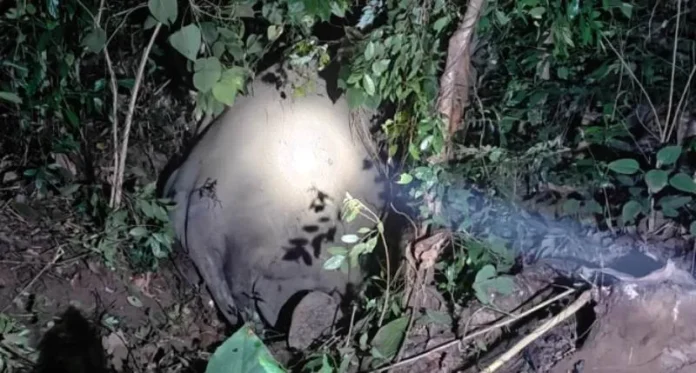A mature elephant was critically injured in a train collision in Khowai district, Tripura, on Saturday night. The tragic incident occurred in the Champlai area, where a local train traveling from Agartala to Dharmanagar collided with the elephant, which was part of a migrating herd moving between its habitats. The animal was found bleeding extensively following the impact.
Incident Details and Immediate Response
According to District Forest Officer (DFO) Akshay Balu Bhorde, the elephant was immediately provided with medical attention after the collision. A veterinary team was swiftly dispatched to the site to assess the animal’s injuries and offer additional care. Bhorde confirmed that the elephant was in a critical condition due to the severity of the injuries sustained in the accident.
“The collision occurred in the Champlai region, when the local train traveling from Agartala to Dharmanagar hit the elephant as it was part of a herd migrating across the tracks,” Bhorde stated. He emphasized that the area is known for wildlife movement, and such incidents involving trains and elephants are unfortunately not uncommon in the region.
Impact on Wildlife and Growing Concerns
Elephants are a vital part of Tripura’s wildlife and often migrate between habitats in search of food and water. The Khowai district, located in the western part of the state, is known for its rich biodiversity, including elephant corridors. However, with the increasing development of infrastructure such as railroads and highways, the safety of wildlife, particularly elephants, has become a growing concern.
The collision highlights a significant issue facing the state, where human-wildlife conflict has escalated due to expanding urbanization and infrastructure development. Elephants, in particular, are at high risk of such accidents, as their migration routes often cross railway tracks and highways.
Efforts to Mitigate Wildlife Collisions
Authorities have been working on several initiatives to mitigate human-animal conflict and reduce the risk of such accidents. Railway authorities and forest departments are collaborating to monitor elephant corridors and implement measures to ensure the safe movement of elephants and other wildlife. Some of these measures include signage, fencing, and increased patrolling of vulnerable areas.
Additionally, the Tripura government has been taking steps to raise awareness about the importance of preserving elephant corridors and providing safe passage for these majestic animals. Efforts have also been made to improve train signaling systems to warn drivers of wildlife presence on tracks.
Elephant Conservation Efforts in Tripura
Tripura is home to a significant elephant population, with elephants migrating across the state’s forests and wildlife sanctuaries. The government, along with conservation groups, has been focusing on elephant conservation through habitat protection, anti-poaching measures, and community engagement.
The state also hosts several wildlife sanctuaries, including the Sepahijala Wildlife Sanctuary, which is home to a variety of flora and fauna, including elephants. However, the increasing risk of accidents involving elephants and human settlements poses a serious challenge to conservation efforts.
Public Awareness and Future Prevention
In light of this incident, authorities are urging the public to be more cautious while traveling through areas known to have elephant populations. The forest department has also called for better coordination between railway officials and wildlife conservation teams to prevent further accidents.
“We are committed to ensuring the safety of both wildlife and the public. Immediate action is being taken to address this issue and improve safety protocols for wildlife in our state,” said Bhorde.
The recent train collision in Khowai district serves as a reminder of the ongoing challenges in managing human-wildlife conflict in Tripura. With elephants playing an integral role in the region’s ecosystem, it is crucial to strengthen conservation efforts, improve infrastructure planning, and implement safety measures to reduce such incidents.




